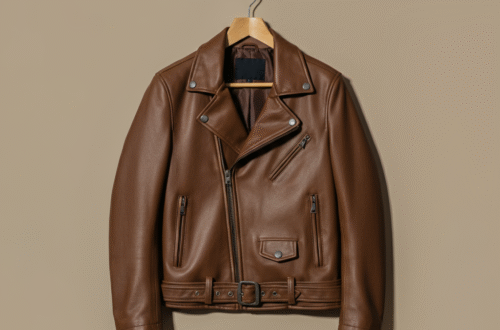Moleskin is a fabric that often brings to mind either comfortable trousers or essential blister protection for hikers. But what exactly is it? Despite its name, this unique material has nothing to do with moles. It’s a heavy cotton fabric, woven and then sheared to create a soft, short pile on one side. This process results in a textile that feels remarkably like the soft fur of a mole, which is how it earned its name. The fabric is known for its incredible softness, durability, and wind resistance, making it a popular choice for clothing and other practical applications for centuries.
This article will explore everything you need to know about moleskin. We will look at its history, how it’s made, and what makes it so special. You will also learn about its various uses, from tough workwear to high-fashion garments. Plus, we will provide tips on how to care for your moleskin items to ensure they last for years to come.
Key Takeaways
- Not Animal-Based: Moleskin is a 100% cotton fabric and does not involve animals. Its name comes from its soft, fur-like texture.
- Durable and Soft: The fabric is known for its unique combination of toughness and softness, making it comfortable yet long-lasting.
- Versatile Uses: Moleskin is used in everything from outdoor clothing and workwear to fashion apparel and medical bandages.
- Easy Care: Generally, moleskin is easy to care for, often being machine washable, but checking the care label is always recommended.
A Brief History of Moleskin Fabric
The story of moleskin begins in medieval Europe. It was first produced as a durable work fabric for laborers, farmers, and hunters who needed clothing that could withstand rough conditions. Its dense weave offered excellent protection from wind and thorns, while its soft surface provided comfort during long days of physical work. The sturdiness of the material made it an ideal choice for people who lived and worked in the countryside. Early versions of the fabric were likely coarse compared to today’s standards, but they served their purpose well.
During the Industrial Revolution, the production of moleskin expanded significantly. British and German factories began mass-producing the fabric, making it more accessible. It became the go-to material for factory workers’ trousers and jackets. Around this time, the German military also adopted moleskin for its uniforms, recognizing its resilience and protective qualities. The fabric’s reputation for being nearly indestructible grew, cementing its place as a staple for tough, reliable clothing.
In the 20th century, moleskin crossed over from pure workwear into mainstream fashion. Its comfortable feel and rugged aesthetic appealed to a broader audience. Today, it is used by high-end brands and everyday clothiers alike, proving its timeless appeal. You can learn more about how classic fabrics evolve on the truefashionstory.com Blog.
How is Moleskin Made? The Unique Process
The creation of moleskin involves a specific weaving and finishing process that gives it its signature characteristics. It all starts with a strong cotton yarn.
The Weaving Stage
The first step is weaving the cotton yarn into a dense twill or satin weave. A satin weave, in particular, is common for moleskin because it places more threads on the surface of the fabric. This technique creates a smooth, lustrous face that is perfect for the next stage. The weave is incredibly tight, which is the foundation of the fabric’s strength and wind-resistant properties. This dense structure ensures that the final moleskin fabric will be tough and able to handle significant wear and tear.
Shearing and Brushing
After weaving, the fabric undergoes a process called shearing. Large machines with sharp blades carefully trim the surface fibers, creating a soft, suede-like nap. This is the most crucial step in giving moleskin its unique texture. The shearing must be done with precision to achieve a uniform, velvety feel without damaging the underlying structure of the fabric. Once sheared, the fabric is often brushed to raise the nap further, enhancing its softness and creating the feel that gives moleskin its name.
The Defining Qualities of Moleskin Fabric
What makes moleskin such a sought-after material? It comes down to a few key properties that set it apart from other cotton fabrics.
Unmatched Durability
The most celebrated quality of moleskin is its durability. The tightly woven cotton threads create a fabric that is exceptionally resistant to abrasion and tearing. This is why it has been a favorite for work trousers and outerwear for generations. A pair of moleskin pants can last for years, often getting more comfortable with age without losing their structural integrity. This resilience makes it a sustainable choice, as it reduces the need for frequent replacement.
Surprising Softness
Despite its toughness, moleskin is incredibly soft to the touch. The sheared nap on its surface feels like suede or velvet, making it very comfortable to wear against the skin. Unlike other heavy-duty fabrics like canvas or denim, which can feel stiff and require a long break-in period, moleskin is soft from the very first wear. This combination of strength and comfort is what makes the material truly special.
Wind and Water Resistance
The dense weave of moleskin makes it naturally wind-resistant. It effectively blocks cold air, making it an excellent choice for jackets and trousers worn in chilly, blustery weather. While it is not fully waterproof, many moleskin fabrics are treated with a water-repellent finish, allowing them to shed light rain and snow. This added protection enhances its utility as an outdoor fabric.
Common Uses for Moleskin
Thanks to its unique properties, moleskin is used in a wide range of products, from practical gear to stylish apparel.
Clothing and Apparel
- Trousers and Pants: This is perhaps the most classic use of moleskin. Moleskin trousers are prized for their comfort and durability, suitable for both casual wear and outdoor activities.
- Jackets and Coats: The wind-resistant nature of moleskin makes it perfect for outerwear. Moleskin jackets provide warmth and protection without the bulk of heavier materials.
- Shirts and Vests: Lighter-weight moleskin is used for shirts and vests, offering a soft texture and a touch of rustic style. These garments are great for layering in cooler weather.
- Workwear: Because of its toughness, moleskin remains a popular choice for durable work clothes in industries like agriculture and construction.
Medical and First-Aid Applications
Beyond clothing, there is another very common type of moleskin: adhesive moleskin. This version consists of a soft cotton flannel with a sticky backing. It is a staple in first-aid kits, especially for hikers and athletes. Its primary use is to prevent blisters. By applying a piece of adhesive moleskin to a “hot spot” on the foot, you can reduce friction between your skin and your shoe, stopping a blister from forming. It can also be used to cushion existing blisters, providing immediate relief.
Moleskin vs. Other Fabrics
How does moleskin stack up against other popular fabrics? Understanding the differences can help you choose the right material for your needs.
Moleskin vs. Denim
Denim is another rugged cotton twill fabric known for its durability. However, denim is typically rougher and stiffer, especially when new. It requires a “break-in” period to soften. Moleskin, on the other hand, is soft from the start. While both are durable, moleskin offers better wind resistance and a more refined, less casual appearance. The look and feel of moleskin are often compared to corduroy or velvet, whereas denim has a distinct, classic workwear look.
Moleskin vs. Corduroy
Corduroy is easily identified by its distinct cords, or “wales.” Like moleskin, it is a durable cotton fabric with a cut pile. However, the texture is very different. Moleskin has a smooth, uniform surface, while corduroy has ridges. Both are warm and comfortable, but moleskin often provides a sleeker silhouette. Corduroy’s texture can add bulk, whereas moleskin drapes more smoothly. The choice between them often comes down to a stylistic preference.
|
Feature |
Moleskin |
Denim |
Corduroy |
|---|---|---|---|
|
Material |
Sheared Cotton |
Cotton Twill |
Cotton with Wales |
|
Texture |
Soft, Suede-like |
Rough, Stiff (when new) |
Ridged, Velvety |
|
Break-in Period |
None |
Yes |
Minimal |
|
Wind Resistance |
High |
Moderate |
Moderate |
|
Primary Use |
Trousers, Jackets |
Jeans, Jackets |
Trousers, Jackets |
|
Appearance |
Refined, Smooth |
Casual, Rugged |
Textured, Casual |
How to Care for Your Moleskin Garments
Proper care is essential to maintain the quality and extend the life of your moleskin clothing. Fortunately, it is generally easy to look after.
Reading the Care Label
The first and most important step is to always check the care label on your garment. While most moleskin is machine washable, some items, especially tailored jackets or those blended with other fibers, might require dry cleaning. The label will provide specific instructions tailored to that particular piece.
Washing and Drying
For machine-washable moleskin, it is best to use cold water and a gentle cycle. This helps preserve the fabric’s color and soft texture. To prevent lint from sticking to the napped surface, wash moleskin items with similar fabrics and turn them inside out before placing them in the machine. Avoid using fabric softeners, as they can build up on the fibers and reduce the fabric’s natural softness over time. When it comes to drying, air-drying is the best option. Lay the garment flat or hang it up to dry. If you must use a dryer, choose a low-heat setting to prevent shrinking and damage to the nap.
Ironing Moleskin
If your moleskin garment becomes wrinkled, you can iron it, but with caution. It is crucial to iron on the reverse side of the fabric to avoid crushing or flattening the soft pile. Use a low to medium heat setting and keep the iron moving to prevent scorching. Placing a pressing cloth between the iron and the fabric can provide an extra layer of protection.
Conclusion
Moleskin is a truly remarkable fabric with a rich history and a versatile future. Its unique combination of rugged durability and exceptional softness sets it apart from other materials. From its origins as humble workwear to its current status in contemporary fashion, moleskin has proven its timeless appeal. Whether you’re looking for a sturdy pair of trousers for outdoor adventures, a stylish jacket for everyday wear, or a reliable solution for blister prevention, moleskin offers a practical and comfortable solution. By understanding how to care for it properly, you can enjoy the benefits of this incredible fabric for many years.
Frequently Asked Questions (FAQ)
Q1: Does moleskin come from moles?
No, moleskin fabric is not made from the skin of moles. It is a heavy cotton fabric that is named for its soft, dense texture, which resembles the fur of a mole.
Q2: Is moleskin waterproof?
By itself, moleskin is not waterproof, but it is naturally water-resistant due to its tight weave. Many manufacturers apply a water-repellent coating to enhance this property, allowing it to handle light rain or snow.
Q3: Is moleskin a good fabric for winter?
Yes, moleskin is an excellent fabric for winter. Its dense construction makes it very wind-resistant, and its soft, napped surface helps trap air, providing good insulation and warmth. It’s a great choice for trousers and jackets in cold weather.
Q4: How do I stop lint from sticking to moleskin?
To minimize lint, wash moleskin garments inside out and with similar fabrics. Avoid washing them with items that produce a lot of lint, like towels. Using a lint roller or brush after washing can also help remove any stray fibers.
Q5: Can moleskin be tailored?
Absolutely. Moleskin is a stable and cooperative fabric, making it easy for tailors to work with. You can have moleskin trousers and jackets altered for a perfect fit, just like garments made from wool or other cottons. For more insights on fabric and fit, check out the articles on the truefashionstory.com Blog.





